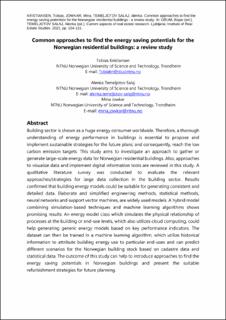| dc.description.abstract | Building sector is shown as a huge energy consumer worldwide. Therefore, a thorough understanding of energy performance in buildings is essential to propose and implement sustainable strategies for the future plans; and consequently, reach the low carbon emission targets. This study aims to investigate an approach to gather or generate large-scale energy data for Norwegian residential buildings. Also, approaches to visualize data and implement digital information tools are reviewed in this study. A qualitative literature survey was conducted to evaluate the relevant approaches/strategies for large data collection in the building sector. Results confirmed that building energy models could be suitable for generating consistent and detailed data. Elaborate and simplified engineering methods, statistical methods, neural networks and support vector machines, are widely used models. A hybrid model combining simulation-based techniques and machine learning algorithms shows promising results. An energy model class which simulates the physical relationship of processes at the building or end-use levels, which also utilizes cloud computing, could help generating generic energy models based on key performance indicators. The dataset can then be trained in a machine learning algorithm, which utilize historical information to attribute building energy use to particular end-uses and can predict different scenarios for the Norwegian building stock based on cadastre data and statistical data. The outcome of this study can help to introduce approaches to find the energy saving potentials in Norwegian buildings and present the suitable refurbishment strategies for future planning. | |
